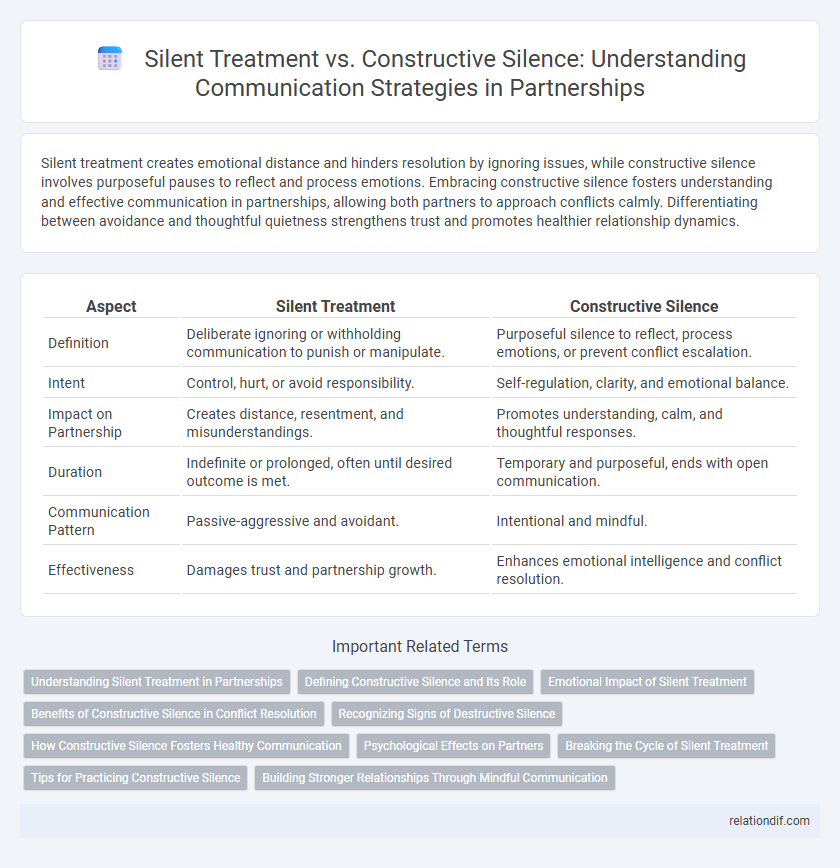Silent treatment creates emotional distance and hinders resolution by ignoring issues, while constructive silence involves purposeful pauses to reflect and process emotions. Embracing constructive silence fosters understanding and effective communication in partnerships, allowing both partners to approach conflicts calmly. Differentiating between avoidance and thoughtful quietness strengthens trust and promotes healthier relationship dynamics.
Table of Comparison
| Aspect | Silent Treatment | Constructive Silence |
|---|---|---|
| Definition | Deliberate ignoring or withholding communication to punish or manipulate. | Purposeful silence to reflect, process emotions, or prevent conflict escalation. |
| Intent | Control, hurt, or avoid responsibility. | Self-regulation, clarity, and emotional balance. |
| Impact on Partnership | Creates distance, resentment, and misunderstandings. | Promotes understanding, calm, and thoughtful responses. |
| Duration | Indefinite or prolonged, often until desired outcome is met. | Temporary and purposeful, ends with open communication. |
| Communication Pattern | Passive-aggressive and avoidant. | Intentional and mindful. |
| Effectiveness | Damages trust and partnership growth. | Enhances emotional intelligence and conflict resolution. |
Understanding Silent Treatment in Partnerships
Silent treatment in partnerships is a passive-aggressive behavior characterized by intentional withdrawal of communication to punish or control a partner, often escalating conflicts and emotional distance. Constructive silence, by contrast, involves intentional pauses to process emotions and reflect before responding, promoting healthier communication and conflict resolution. Understanding these distinctions is crucial for partners to recognize harmful patterns and foster emotional intimacy through mindful silence.
Defining Constructive Silence and Its Role
Constructive silence in partnership involves intentional, thoughtful pauses that allow reflection, de-escalation of tension, and space for emotional regulation, unlike the harmful silent treatment which fosters resentment and miscommunication. This practice supports healthier conflict resolution by promoting mindful listening and understanding, enhancing mutual respect and connection between partners. Employing constructive silence strengthens communication dynamics and contributes to long-term relational stability.
Emotional Impact of Silent Treatment
Silent Treatment in partnerships often causes emotional distress, leading to feelings of rejection, confusion, and increased anxiety, which can deteriorate trust and intimacy. Constructive Silence, by contrast, serves as a purposeful pause for reflection, promoting emotional regulation without damaging the connection. Understanding this distinction is crucial for maintaining healthy communication and emotional well-being within relationships.
Benefits of Constructive Silence in Conflict Resolution
Constructive silence fosters emotional regulation by allowing partners to cool down, preventing impulsive reactions that escalate conflicts. This approach encourages reflective listening and thoughtful responses, enhancing mutual understanding and empathy in the relationship. Utilizing constructive silence promotes effective communication, ultimately strengthening trust and collaboration between partners.
Recognizing Signs of Destructive Silence
Recognizing signs of destructive silence in a partnership involves noting prolonged withdrawal, avoidance of meaningful communication, and emotional detachment that hinder conflict resolution. This form of silent treatment damages trust and intimacy by creating confusion and resentment between partners. Constructive silence, by contrast, allows for thoughtful reflection and emotional regulation without escalating tension.
How Constructive Silence Fosters Healthy Communication
Constructive silence serves as a powerful tool in partnerships by allowing individuals to process emotions and thoughts without immediate reaction, fostering clarity and reducing misunderstandings. Pausing conversation intentionally creates space for reflection, which encourages thoughtful responses and mutual respect. This mindful approach improves communication quality, strengthens trust, and supports conflict resolution effectively.
Psychological Effects on Partners
Silent treatment in partnerships often triggers feelings of rejection, anxiety, and emotional distress, leading to increased tension and unresolved conflicts. Constructive silence, by contrast, provides space for reflection and emotional regulation, fostering clearer communication and mutual understanding. The psychological effects of constructive silence contribute to healthier emotional resilience and strengthened relational trust between partners.
Breaking the Cycle of Silent Treatment
Breaking the cycle of silent treatment in partnerships requires recognizing the difference between harmful silence and constructive silence, where the latter serves as a calming pause to prevent escalation. Constructive silence allows partners to process emotions and reflect without resorting to blame, fostering healthier communication patterns. Establishing clear boundaries and encouraging open dialogue after moments of silence can transform negative silence into opportunities for growth and understanding.
Tips for Practicing Constructive Silence
Practicing constructive silence in a partnership involves actively listening without interrupting, allowing space for reflection and emotional processing. Focus on non-verbal communication cues like body language and eye contact to convey empathy and understanding during moments of pause. Setting clear intentions about using silence to de-escalate conflicts rather than avoid issues promotes healthier, more effective communication.
Building Stronger Relationships Through Mindful Communication
Silent treatment often damages relationships by creating emotional distance and unresolved conflicts, while constructive silence fosters reflection and thoughtful responses. Mindful communication through intentional pauses allows partners to process emotions and avoid reactive exchanges, promoting understanding and empathy. Building stronger relationships relies on distinguishing between harmful silence and purposeful quiet to enhance trust and connection.
Silent Treatment vs Constructive Silence Infographic

 relationdif.com
relationdif.com